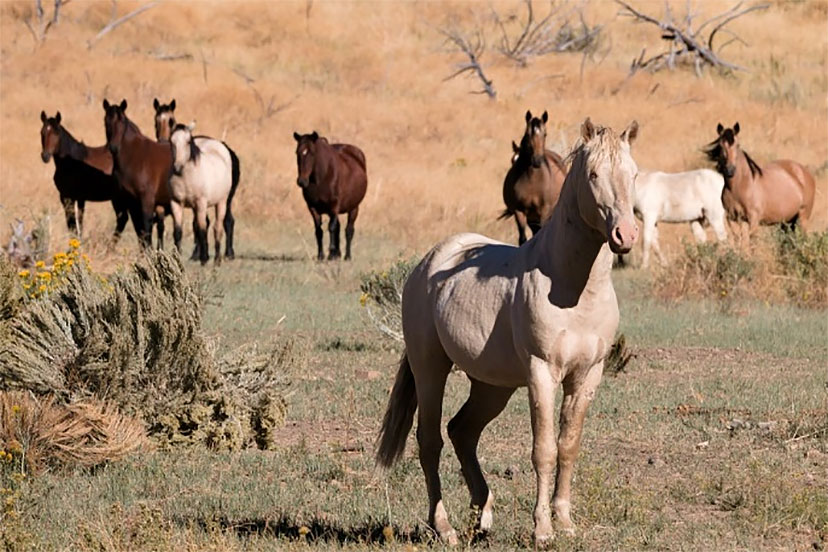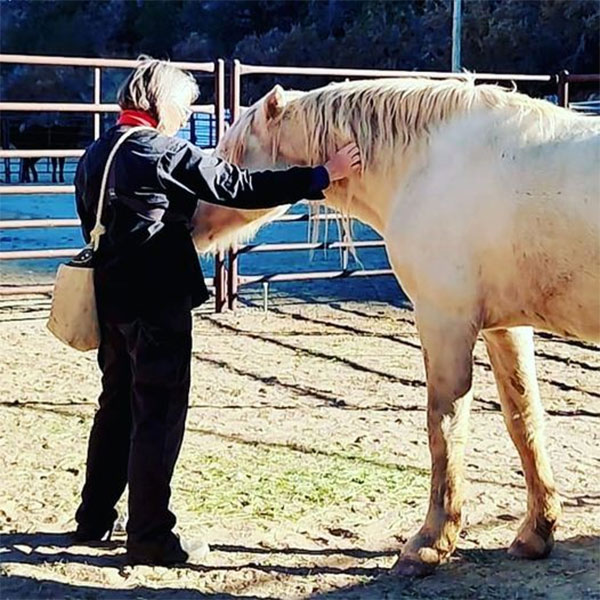By Patty Latham, DVM
Marvel bolted from the shade of towering golden crowned cottonwoods, his coat a metallic pearl, fingers of light lacing his mane bleached pumpkin. The two-year-old stallion stood blinking his blue eyes in shock not only at the bright morning sun on Halloween eve but also at the peering human ‘predators’ lining the round pen against the backdrop of the salmon-colored sandstone of Canyons of the Ancients along McElmo Creek.
Marvel dropped his head, confined to the pen after his capture at Mesa Verde National Park thirty-two days before. He was full of freely available hay and most importantly, he had water, clear, cold water, in a metal tub he’d come to find as life giving. Exhausted, secure enough with two previously tamed mustangs close by, he blinked repeatedly. Twenty hands quietly held out morsels of sweet alfalfa hay. He rested, a wild horse from a drought-stricken land.
https://www.youtube.com/channel/UCztJ2-SGTK1UPZwAfiV4GCg
I had come to observe the stress-free training clinic presented by Dr. Patricia Barlow-Irick from Mustang Camp, Blanco, New Mexico. The clinic, sponsored by the National Mustang Association of Colorado (NMACO), focused on the use of positive reinforcement and low stress methods for taming and training wild and feral horses. The project is specifically associated with the gather and adoption of the horses of Mesa Verde National Park. Marvel was the first of the wild horses to be gathered and removed from the park. The first to be saved.
Wild horses at Mesa Verde National Park?
I had never seen them there, but reviews of the Morefield Campground online sometimes pictured a herd moving through, a tourist attraction. At least nine small bands of wild horses are landlocked in four or more canyons and on three or more mesas in the park. Water sources are rare, becoming nonexistent with the years of drought.
History, repeating itself?
People had inhabited the green mesa top since 7500 BC, archaic people, basket makers, then Ancestral Puebloans building rock shelters in 750 AD. By 1300 AD, the nomadic family groups of the Ute tribes migrated from the Great Basin into the Four Corners region, hunting and gathering across Colorado, including the mesa country of the southwest. With the explorations of the Spanish beginning in 1604 from Santa Fe, New Mexico, and north into Colorado, the Utes acquired the horse and the mobility to hunt, raid, and migrate. By 1776, Ute tribes had a highly developed tradition of horse use.
The Ute people became the People of the Horse.
Horses escaped and proliferated in the novel land. Horses have inhabited Mesa Verde country for at least a couple hundred years.
The Old Spanish Trail, a trade route between Santa Fe and California, used by pack trains in the late 1820s, provided new opportunities for trading, looting, immigrants, and escaping horses. By the 1870s, gold was discovered in the southwest mountains of Colorado, and the Brunot Treaty of 1873 was negotiated which resulted in the ceding of the San Juan and La Plata Mountains by the Ute to the U.S. government and the Ute reservation was restricted to a strip along the southwest borders of Colorado, including Mesa Verde country.
But Mesa Verde, the green table, had no rivers, no streams. It is high desert, dry plains dissected by canyons that make the topography look like crocodile skin from above. The people, the wildlife, the free ranging horses were dependent on springs or seeps or on the ability to travel steep sandstone canyon trails to reach water far below and miles away.
Mesa Verde was established as a national park in 1906, but the deceptive land grab from the Ute tribes in Colorado failed to include the most spectacular of the Ancient Puebloan cliff dwellings. The Assistant Commissioner of Indian Affairs and the Inspector with the Department of Interior negotiated a land exchange with the Weminuche Utes that was signed May 10, 1911, expanding Mesa Verde National Park about 3.75 miles southward, that addition surrounded by the Ute reservation. No one told the horses ranging across the park along with the elk and deer.
Trespass Livestock are prohibited in the National Park
According to the park service, horses are not considered indigenous wildlife and the park does not allow livestock grazing under its management policy. In addition, the horses at Mesa Verde do not fall under the protection of the Wild horse Free-Roaming Horse and Burro Act. That law identifies specific public lands in the West where wild horses are managed long term under the Bureau of Land Management (BLM). Mesa Verde is not included.
In October 2013, the park’s wildlife biologist stated that, instead of developing a management plan for the horses, the park would “use fencing to keep horses away from water sources.” The Denver Post reported that this would “serve as a sort of management tool: Lack of water will force the horses to go elsewhere, and when horses are under stress from too little food or water, they are less fertile.”
In the summer of 2014, at least six horses in the park died from dehydration after the park superintendent, citing “standard protocol for wildlife management on public lands,” blocked their access to available water. Now those water sources are scarce.

Climate Change and the ongoing drought in the Southwest
For several years, NMACO negotiated unsuccessfully with the National Park Service at Mesa Verde to manage the horses there with injectable fertility vaccine, but the National Park Service considers the horses incompatible with the antiquities and archaeological sites and plans to remove the horses. With the multi-year drought in the southwest, available springs and seeps are drying up.
Morefield Spring at Mesa Verde, supplying two or three herds of wild horses as their sole water source, ran dry in September.
Much as drought and conflict triggered the migration of the Ancient Puebloans from Mesa Verde, drought has caused a crisis for the wild horses of Mesa Verde. The Park has agreed to allow habituation, bait trapping, and eventual low stress removal of the horses. NMACO will have title and possession of the horses for their training and further adoption.
A Thanksgiving Update on Marvel
Marvel is now a gelding, vaccinated, and transported to Mustang Camp. He has no reason to fear humans thanks to his planned habituation to two-legged critters providing water, salt, and food and his low stress capture methods. No helicopters, no cowboy roundups.
Vigilant by nature, trusting from his gentle handling, he follows his people around like a puppy, targeting fingers to ask for a bite of hay, no longer frantically searching for water.
It is estimated that capture, feed, veterinary care, and training for each of the 70-80 wild horses of Mesa Verde may cost upwards of $300,000, but the goal is a successful human-equine relationship for these horses. They need help. Funds and homes.
Please contact NMACO for additional information, updates, and to donate: https://nmaco.org/mesa-verde/
Patty Latham lives in Chromo, Colorado.


